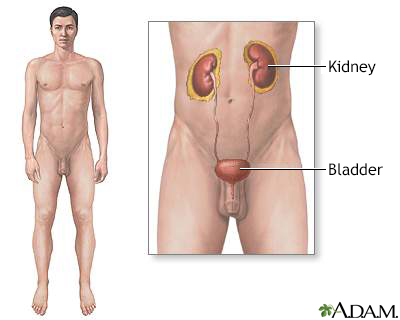Retroperitoneal fibrosis
Idiopathic retroperitoneal fibrosis; Ormond's disease
Retroperitoneal fibrosis is a rare disorder that blocks the tubes (ureters) that carry urine from the kidneys to the bladder.
Images

I Would Like to Learn About:
Causes
Retroperitoneal fibrosis occurs when extra fibrous tissue forms in the area behind the stomach and intestines. The tissue forms a mass (or masses) or tough fibrotic tissue. It can block the tubes that carry urine from the kidney to the bladder.
The cause of this problem is mostly unknown. It is most common in people aged 40 to 60. Men are twice as likely to develop the condition as women.
Symptoms
Early symptoms:
- Dull pain in the abdomen or flank that increases with time
- Pain and change of color in the legs (due to decreased blood flow)
- Swelling of one leg
Later symptoms:
- Decreased urine output
- No urine output (anuria)
- Nausea, vomiting, changes in mental status caused by kidney failure and build-up of toxic chemicals in the blood
- Severe abdominal pain with blood in the stool (due to death of intestinal tissue)
Exams and Tests
Abdominal CT scan is the best way to find a retroperitoneal mass.
Other tests that can help diagnose this condition include:
- BUN and creatinine blood tests
- Intravenous pyelogram (IVP), not as commonly used
- Kidney ultrasound
- MRI of the abdomen
- CT scan of the abdomen and retroperitoneum
A biopsy of the mass may also be done to check for cancer.
Treatment
Corticosteroids are tried first. Some health care providers also prescribe a drug called tamoxifen.
If corticosteroid treatment does not work, a biopsy should be done to confirm the diagnosis. Other medicines to suppress the immune system can be prescribed.
When medicine does not work, surgery and stents (draining tubes) are needed.
Outlook (Prognosis)
The outlook will depend on the extent of the problem and the amount of damage to the kidneys.
The kidney damage may be temporary or permanent.
Possible Complications
The disorder may lead to:
- Ongoing blockage of the tubes leading from the kidney on one or both sides
- Chronic kidney disease or failure
When to Contact a Medical Professional
Contact your provider if you have lower abdomen or flank pain and less output of urine.
Prevention
Try to avoid long-term use of medicines that contain methysergide. This drug has been shown to cause retroperitoneal fibrosis. Methysergide is sometimes used to treat migraine headaches.
Related Information
Chronic kidney diseaseReferences
Comperat E, Bonsib SM, Cheng L. Renal pelvis and ureter. In: Cheng L, MacLennan GT, Bostwick DG, eds. Urologic Surgical Pathology. 4th ed. Philadelphia, PA: Elsevier; 2020:chap 3.
Nakada SY, Best SL. Management of upper urinary tract obstruction. In: Partin AW, Dmochowski RR, Kavoussi LR, Peters CA, eds. Campbell-Walsh-Wein Urology. 12th ed. Philadelphia, PA: Elsevier; 2021:chap 89.
Privratsky AM, Barreto JC, Tumage RH. Abdominal wall, umbilicus, peritoneum, mesenteries, omentum, and retroperitoneum. In: Townsend CM Jr, Beauchamp RD, Evers BM, Mattox KL, eds. Sabiston Textbook of Surgery. 21st ed. Philadelphia, PA: Elsevier; 2022:chap 44.
Shanmugam VK. Vasculitis and other uncommon arteriopathies. In: Sidawy AN, Perler BA, eds. Rutherford's Vascular Surgery and Endovascular Therapy. 10th ed. Philadelphia, PA: Elsevier; 2023:chap 138.
BACK TO TOPReview Date: 4/1/2023
Reviewed By: Kelly L. Stratton, MD, FACS, Associate Professor, Department of Urology, University of Oklahoma Health Sciences Center, Oklahoma City, OK. Also reviewed by David C. Dugdale, MD, Medical Director, Brenda Conaway, Editorial Director, and the A.D.A.M. Editorial team.

Health Content Provider
06/01/2025
|
A.D.A.M., Inc. is accredited by URAC, for Health Content Provider (www.urac.org). URAC's accreditation program is an independent audit to verify that A.D.A.M. follows rigorous standards of quality and accountability. A.D.A.M. is among the first to achieve this important distinction for online health information and services. Learn more about A.D.A.M.'s editorial policy, editorial process and privacy policy. A.D.A.M. is also a founding member of Hi-Ethics. This site complied with the HONcode standard for trustworthy health information from 1995 to 2022, after which HON (Health On the Net, a not-for-profit organization that promoted transparent and reliable health information online) was discontinued. |
The information provided herein should not be used during any medical emergency or for the diagnosis or treatment of any medical condition. A licensed medical professional should be consulted for diagnosis and treatment of any and all medical conditions. Links to other sites are provided for information only -- they do not constitute endorsements of those other sites. © 1997- 2024 A.D.A.M., a business unit of Ebix, Inc. Any duplication or distribution of the information contained herein is strictly prohibited.
